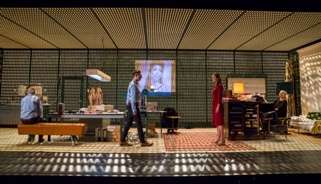|
Back
Ivo van Hove’s Setting of Leos Janácek’s Diary of One Who Disappeeared New York
Howard Gilman Opera House
04/04/2019 - & April 5, 6, 2019
Leos Janácek: Diary of One Who Disappeared
Wim van der Grijn (Actor), Andrew Dickinson (young Leos Janácek) Marie Hamard (Gypsy), Raphaële Green, Annelies Van Gramberen, Naomi Beeldens (Trio)
Lada Valesová (Piano)
Ivo van Hove (Director), Krystian Lada (Dramaturgy), Jan Versweyveld (Set and lighting design), An D’Huys (Costume design)

W. van der Grijn A. Dickinson, M. Hamard, L. Valesová (© Richard Termine)
All the elements, as Czech composer of Leos Janácek would have it, conspired to create a hot bed of passion and creativity in the last years of his life. The composition of the odd song cycle/cantata/chamber opera The Diary of One Who Disappeared (1917) marked the pivot of the composer into his last act. It was based on poems by Ozef Kalda which had appeared in a Brno newspaper the year before.
Ivo van Hove won a Tony award for his direction of Arthur Miller’s View From the Bridge. In the production, he brilliantly stripped away everything but raw emotion from each character. This exposure made the play work on an elemental and exciting level. Van Hove’s take on the Janácek cycle, although it features a photographer, does not expose the work’s emotional core.
Van Hove’s direction of Diary of One Who Disappeared is produced by Muziektheater Transparant (joined by companies from China, Brussels, Luxembourg and Holland) and now mounted at the Howard Gilman Opera House at the Brooklyn Academy of Music (BAM). Van Hove has brought the cycle into the present. He replaces the composer’s role with a photographer. The ploughman featured in the published poems becomes Janácek himself as a young man and the gypsy’s role is daringly expanded by composer Annelies Van Parys.
The rich palette of a photographer’s workspace is created on stage by Jan Versweyveld. The red lights of a darkroom are mirrored in the gypsy’s hot red dress. The aging photographer projects an image of a naked woman over his body as he spreads his arms crucifixion-style. On a central desk, projection equipment is lined up. Beneath it, boxes containing, one assumes, carousels of slides are stacked.
Stage left a piano played by Lada Valesová, who beautifully captures the composer’s spare score. The pianist is backed by a sofa couch with sheets open. On the piano are dead leaves, which suggest that what is happening before us in fact, happened long ago. A window keeps the outdoor backyard continuously in frame.
As the young Janácek (originally a ploughman), Andrew Dickinson sings with stirring strength and passion, suggesting the heat of Janácek’s own feelings as he awakes from years of a loveless marriage and the early death of his two children. Fate brings Kamila Stösslová into his life. Musical scholars are fond of spending careers on the Sisyphean task of determining whether or not relationships are consummated. Did Brahms bed Clara Schumann? We will probably never know. The same can be said of Janácek and Kamila. What seems important, however, is the passions the idea of this young woman stimulated. Most scholars agree that the last works of the composer were inspired by the intense and wild feelings she aroused. She became his muse.
As he worked on the cycle, Janácek wrote to Kamila, “regularly in the afternoon a few motifs occur to me for the poems about Gypsy love. Perhaps a nice little musical romance will come out of it.” The cadences become a country of melody and desire. We begin hearing of:
Dappled woodland light,
Spring well chill and bright,
Eyes like stars at night,
Open knees so white.
Four things death itself won’t cover,
Unforgettable forever.
Van Hove has made two significant changes in the cycle. He has added music to the gypsy’s minor role in Janácek’s composition. Composer Van Parys has written music from the Romany gypsies to enhance the gypsy’s musical presence, and this works remarkably well. Her writing gives voice to the Zefka, and allows us to absorb her emotional evolution. Mezzo Marie Hamard has made the role her own, and is as mysterious and exotic in person as she is in the composer’s infatuated mind. Her voice is echoed by a group of three female voices who remain off stage. The cycle concludes with the composer burning Kamila’s letters at her request. How much we are missing is hard to say. Janácek would write: “...And the black gipsy girl in my Diary of One Who Disappeared – that was you. That’s why there’s so much emotional fire in the work. So much fire that if we both caught on, we’d be turn into ashes. ...And all through the work I thought of you! You were my Zofka. Zofka with a child in her arms, and he runs after her!...” Kamila replied that milk was expensive at the local store.
Janácek’s will is also quoted in the revised production. Kamila was to receive everything in the original version of the will which was thrown out by a court. She did receive royalties from the magnificent works she inspired, Káťa Kabanová, From the House of the Dead and the Second String Quartet.
Van Hove tackles this complex piece with his always interesting take. Yet we are not left with the sense that the Diary cycle was a pivot for Janácek into compositions of great passion and musical beauty.
Susan Hall
|